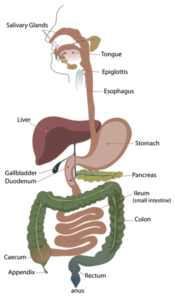My journey of well-being has provided a glimpse into the inner working of my digestive track. I’ve shared my newfound knowledge in posts entitled Our Guts Have Minds of Their Own, The Marvelous Microbiome, and SIBO and Leaky Gut. I added to my intestinal intelligence through Wondrium’s Gut Health with Dr. Mary Pardee. This 26-lesson course covers the mechanics of digestion, strategies for maintaining a heathy gut, gut pathologies, and gut testing and treatment. While there was a fair amount of overlap with what I’d read previously, I managed to come away with a few new insights.
 If you’re curious about your gut health, your daily constitution provides a pretty good indication on how things are going. A healthy poop should be soft, brown, S-shaped, and the length of the wrist crease to elbow crease. It might be tinged red, orange, or green based on foods eaten recently – e.g., red beets, squash, dark leafy greens. It should not be particularly malodorous or greasy. And it should not be bloody. Dietary adjustments and fluid intake can cure a multitude of sins. Bloody stools should be brought to a doctor’s attention.
If you’re curious about your gut health, your daily constitution provides a pretty good indication on how things are going. A healthy poop should be soft, brown, S-shaped, and the length of the wrist crease to elbow crease. It might be tinged red, orange, or green based on foods eaten recently – e.g., red beets, squash, dark leafy greens. It should not be particularly malodorous or greasy. And it should not be bloody. Dietary adjustments and fluid intake can cure a multitude of sins. Bloody stools should be brought to a doctor’s attention.
As covered in the post Drink Water, there’s all kinds of reasons why we should consume an adequate amount of fluid daily (though not to excess at any one time). Dr. Pardee suggests that we take in most of our water between meals. The liquid we drink at meal time can dilute our stomach acid and make it less effective for processing food and killing off bacteria. Older adults are particularly vulnerable in this regard as stomach acid drops as we age. It’s best to confine meal time beverage intake to a handful of sips just to keep things moist.
How we eat is as important as what we eat. Digestion begins with the sight and smell of food; they make our mouths water. Saliva moistens food upon entry into the oral cavity and also starts the process of breaking it down chemically. Of course, chewing represents the most effective form of breakdown. We should transform solid food into the consistency of baby food before swallowing. Big chunks of food are challenging for the stomach to process into a form acceptable by the small intestine.
Meals should benefit from focused attention. When we’re mindful of what we’re eating, we’re more likely to sense satiety and less likely to overeat. Mindful eating also helps us notice whether we’re actually hungry or eating for some other reason – e.g., boredom, stress. It also provides the means to really savor our food and be grateful for its nourishing presence.
Speaking of stress, it’s not a good idea to chow down when in the grips of a fight, flight, or freeze response. In this state, the body shuts down nonessential functions and directs its energy and blood supply to the muscles. It does not want mess around with digestion until the threat has passed. As such, stress eating really, really does not make sense!
Regular exercise supports strong motility along the digestive track. As we move, our food moves through our bodies. This movement prevents an overgrowth of bacteria in the gut and can avoid painful elimination. Dr. Pardee suggests that we aim for 10,000 steps per day. A good night’s sleep also supports motility by elevating cortisol first thing in the morning to a level that stimulates bowel movement. For those with chronic motility issues, fresh ginger, ginger capsules, and ginger tea (2-3 tea bags per cup steeped 10 minutes) may prove helpful.
As with other experts in the field, Dr. Pardee is big on a healthy eating to promote a healthy gut microbiome. Ideally, three-quarters of the plate for every meal includes a varied array of non-starchy vegetables. Daily fiber intake should trend upwards of 100 mg daily through natural sources. (The average American only consumes 15 mg of fiber!) A generous supply of herbs provides potent antioxidants (e.g., polyphenols) to quell systemic inflammation. Fermented foods help the gut garden thrive. And for good measure, eliminate dairy and go easy on nuts.
While probiotics have become a staple of the microbiome conscious, they don’t colonize the gut; they’re transient. They may help reduce anxiety, lower cortisol levels, or support pain management while working their way through the system, but they’re not a panacea for a gut that’s off kilter. Healthy eating, regular exercise, and good sleep habits are the gut’s best friends.